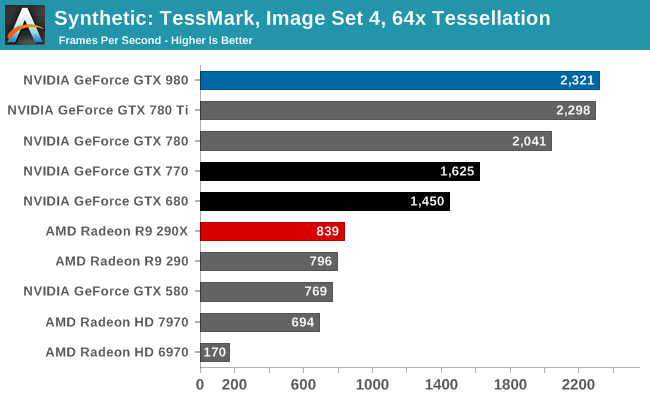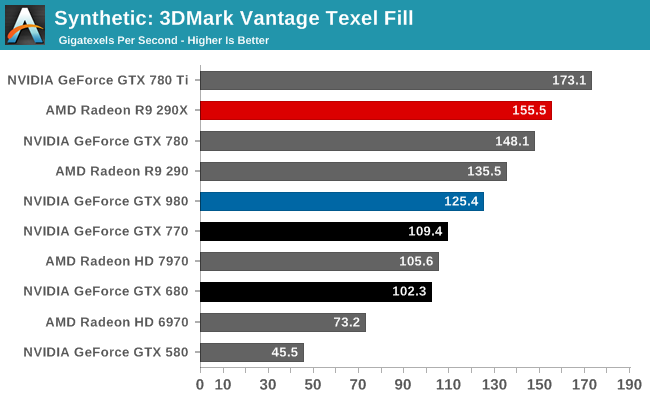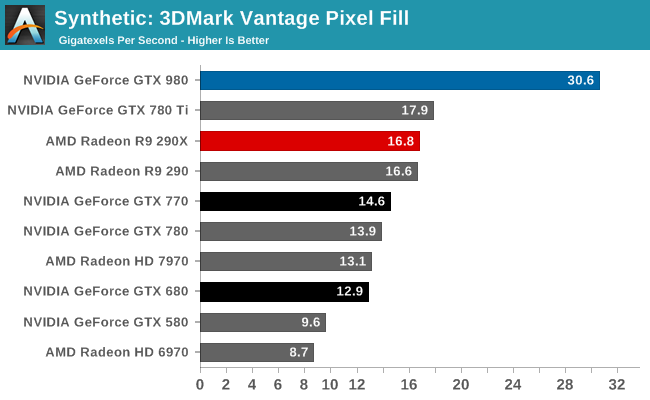The NVIDIA GeForce GTX 980 Review: Maxwell Mark 2
by Ryan Smith on September 18, 2014 10:30 PM ESTSynthetics
As always we’ll also take a quick look at synthetic performance. These tests mainly serve as a canary for finding important architectural changes, and with the exception of pixel throughput we are not expecting any major changes for GTX 980 and GM204.

GM204 is designed to have an ever-so-slightly higher triangle throughput rate than GK110 – 16 tris/clock versus 15 tris/clock, and sure enough the GTX 980 comes out on top in TessMark, slightly edging out the GTX 780 Ti. The difference is only very slight here, and though GM204 should be a bit more powerful than GK110 in practice it’s a dead heat.
Moving on, we have our 3DMark Vantage texture and pixel fillrate tests, which present our cards with massive amounts of texturing and color blending work. These aren’t results we suggest comparing across different vendors, but they’re good for tracking improvements and changes within a single product family.

Beginning with Maxwell NVIDIA reduced their texture-to-compute ratio from 12:1 to 16:1. As a result of this change Maxwell GPUs have fewer texture units than comparable Kepler GPUs. Compounding this effect is the fact that Maxwell CUDA cores are more efficient than Kepler CUDA cores, leading to NVIDIA placing fewer cores overall and further reducing the texture fill rate.
As a result the GTX 980 is not texture fillrate competitive with any of the GK110 cards. It is competitive with the GK104 cards, but only because these cards had the same number of texture units at 128. NVIDIA has told us that they believe this new ratio is a better fit for modern workloads, and judging from the performance we’re seeing elsewhere it would appear that NVIDIA is right.

On the other hand, thanks to NVIDIA’s newer 3rd generation delta color compression technology, our 3DMark pixel fillrate performance is through the roof. GTX 980 comes very close to doubling the throughput of our GK110 cards and more than doubles the throughput of the GK104 cards, reflecting the fact that it has 64 ROPs and more importantly has the available bandwidth to put them to good use.
This benchmark in a nutshell is why NVIDIA can deliver chart-topping performance despite having only 2/3rds the memory bandwidth of GTX 780 Ti. By improving their color compression to this point, NVIDIA can significantly reduce their memory bandwidth requirements Maxwell 2, allowing them to do more with less. In real games the result won’t be anywhere near this remarkable since this is a pure pixel fillrate test, but it goes to show that NVIDIA has been able to expand their effective memory bandwidth in concert with their ROP and shader performance improvements.










274 Comments
View All Comments
hojnikb - Friday, September 19, 2014 - link
7950 (which was then rebranded to 280) had 200W. With 280, they obviously upped the TDP for longer turbo speeds.ArtForz - Saturday, September 20, 2014 - link
Wasn't the 280 more of a rebranded 7950 boost (925 turbo), and not a 7950 (825, no turbo at all)?Mr Perfect - Friday, September 19, 2014 - link
True, but the 285 didn't live up to the 180 watt claim. Later in the article they showed it saving only 13 watts under load when compared to the 280. So more like 237 watts?http://www.anandtech.com/show/8460/amd-radeon-r9-2...
Which was really quite disappointing. I need something to cram in my mITX rig, and it has to be close to the 150 watts of the 6870 in there now.
Samus - Friday, September 19, 2014 - link
On a per-watt scale, AMD's GPU's are now as inefficient as their CPU's when compared to the competition. It's good they got those console contracts, because they probably won't be getting the next round if this keeps up.Absolutely amazing Maxwell is twice as efficient per watt as GCN 1.2
Laststop311 - Friday, September 19, 2014 - link
well looks like the gtx 970 is calling your name thenAlexvrb - Saturday, September 20, 2014 - link
That seems to depend on the design reviewed. THG tested a similarly clocked card by a different manufacturer and there was a much larger gap between the 280 and 285 in terms of power consumption.With that being said the 980 and 970 are both extremely fast and power efficient. Especially the 970 - if it really hits the market at around that pricing wow! Incredible value.
Strange that the 980 throttles so much at stock settings even outside of Furmark, first thing I'd do is go into the settings and fiddle a bit until it boosts consistently. But given its performance and it's not really a problem, and it can be remedied. Still, something to keep in mind especially when overclocking. I wonder how the 980 would have done with the beefier cooler from its higher-TDP predecessors, and some mild overvolting?
Laststop311 - Sunday, September 21, 2014 - link
If you look in the gaming benchmarks the gpu is hitting 80C. Nvidia's design does not allow the gpu to exceed 80C so it has to lower frequencies to stay at 80C. This is the consequence of using the titan blower cooler but removing the vapor chamber lowering its cooling capability. That's why I don't get why all these people are rushing to buy the reference design gtx 980's as they are all sold out. They are throttling by hundreds of mhz because the titan blower cooler without a vapor chamber sucks. Custom cooling options are going to make the gtx 980 able to reliably hit 1300-1400 mhz some probably even 1500 mhz under full load and still stay under the 80C limit. Keep an eye out for MSI's twin frozr V design. It's going to have a beefy radiator with 2x 100mm fans in an open air design allowing WAY more cooling potential then the reference design. The twin frozr V design should allow the card to OC and actually keep those OC frequencies under heavy load unlike the reference card which cant even keep up with its stock setting under intense gaming. We should see a pretty big performance jump going to custom coolers and the reference performance is already staggeringAlexvrb - Sunday, September 21, 2014 - link
Reviewers and "tech enthusiasts" alike jumped all over AMD when they didn't adequately cool their 290 cards. So while I don't disagree with what you're saying, I am just surprised that they would let it ship with such heavy throttling on ordinary games. Especially given that in this case it isn't because Nvidia shipped with a cooler that isn't sufficient - rather it's because by default the fan is running too slowly. Even without the vapor chamber, I bet it would be fine if they just turned up the fan just a hair. Not enough to make it loud, but enough to bring it in line with some of the other high-end cards here (under a load).Anyway I suspect the vapor chamber will return in a higher-end "980 Ti" type configuration. In the meantime, yeah I'd keep an eye out for high-end aftermarket designs with a more aggressive power delivery system and wicked cooling. There's no doubt these chips have serious potential! I'd bet an aggressive 970 could hit the market for under $400 with 980-like performance and a factory warranty. :D
I'd say "poor AMD" but this kind of leapfrogging is nothing new. Even if AMD can't come out with something really impressive in the next several months, they can always remain competitive by dropping prices. My GPU is idle outside of gaming so the actual difference in power consumption in terms of dollars is tiny. Now, for number-crunching rigs that run their GPUs 24/7... that's a different story altogether. But then again, AMD's professional cards have good DP numbers so it's kind of a wash.
Hixbot - Monday, September 22, 2014 - link
I'm very disappointed they got rid of the vapor chamber. I'm not a fan of the 3rd party coolers as they exhaust the air into the case (big deal for small form factor PCs). I prefer the blower cooler even though they are noisier, the loss of the vapor chamber is a big deal.Viewgamer - Friday, September 19, 2014 - link
LOL people screaming at the 285. It actually consumes less power than the 980 and 970 not more.Nvidia greatly understated the TDP of the 980 and 970 to put it lightly.
Both cards consume more power than the 250W TDP 7970 Ghz yet they're somehow rated at 165W and 145W how laughable !
http://i.imgur.com/nfueVP7.png